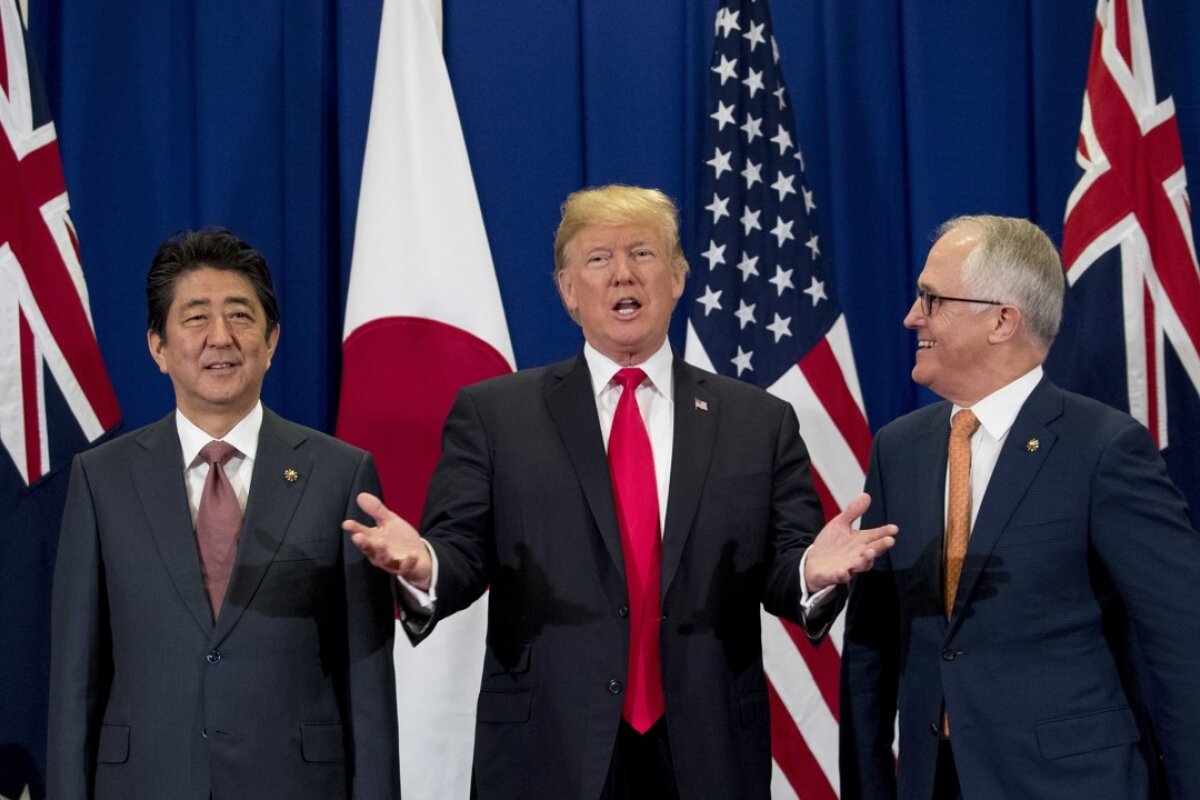U.S., Japan, Australia, and India Meet to Discuss Growing Power of China
Former Japanese Prime Minister Shinzo Abe, current US President Donald Trump, and Australian Prime Minister Malcolm Turnbull. Source.
In 1978, China was a struggling country with a low GDP of only $150 billion. In 2020, China is a rising superpower with a GDP of $14.3 trillion. With its growing power, China has been moving to change the established world order with new strategies to exert influence as an economic powerhouse. Now, China’s rivals believe it is time to retaliate.
Earlier this month, the U.S., Japan, Australia, and India held a discussion regarding China. Together, these four countries make up the Quadrilateral Security Dialogue (commonly referred to as “the Quad”). The Quad is an informal forum for these fours countries to hold semi-regular summits and information exchanges. Their discussion revolved around China’s increasingly assertive actions across the Indo-Pacfiic Region.
Why have China’s actions been causing concern? China has slowly been trying to build stronger relations with the islands located in the South Pacific. For most of the post-WWII era, the south pacific islands occupied an insignificant position on the world stage, owing to their collective population of 13 million people and status as a developing region. China changed this. Since 2006, China’s trade, aid, commercial, and diplomatic activity in the Pacific region has been increasing. Between 2006 and 2017, China granted nearly. $1.5 billion in foreign aid to the Pacific Islands region through a mixture of grants and loans. The nature of this aid sometimes comes in the form of large infrastructure projects funded by concessional loans. Chinese lending of this kind has been used as a method of getting Chinese state-owned enterprises into the region.
The concerns of the U.S., Japan, India, and Australia can be partly explained with two words: debt-trap diplomacy. Debt-trap diplomacy is a strategy where a country may lure developing or underdeveloped countries to borrow money for infrastructure projects and later gaining leverage in some form if they fail to pay off their loans in time. Considering that developing countries tend to have less funds to pay off the loans and higher levels of corruption, paying off the loan may be a struggle, making debt-trap diplomacy a viable strategy. This strategy worked in Sri Lanka, a developing nation off the coast of India. After Sri Lanka could no longer afford to pay off its debt that it took on from China to build a new port, its government agreed to hand over the port and 15,000 acres of land around it to China for 99 years. A strategic win, this transfer gave China control of territory just a few hundred miles off the shores of a rival, India, and a strategic foothold with a well-located port.
According to John Adams, there are two ways to “enslave” a nation, in his words: by sword or by debt. Opponents of China believe that China is gaining control of other nations through debt.
With as aggressive a tactic like this coming from China, the Quad has to act. U.S. Secretary of State Mike Pompeo, relied on strong words: “It is more critical now than ever that we collaborate to protect our people and partners from the Chinese Communist Party’s exploitation, corruption and coercion.” Pompeo accused China of both covering up the pandemic and worsening it, and of threatening freedom, democracy and diversity in the Pacific region with its increasingly assertive actions. Meanwhile, other attendees used more nuanced language and used the meeting to argue for the significance of FIOP. FIOP, or “The Free and Open Indo-Pacific” is a strategy with the aim to maintain and strengthen a rules-based and open maritime order to prevent instability and conflict and specifically avoid any one country’s dominance in the maritime domain of the Indo-Pacific region.
Pompeo made the U.S. stance on China clear, but Japan is stuck. Yoshihide Suga, Japan’s new Prime Minister, has little experience in diplomacy and must strike a balance between its relations with the U.S., Japan’s main security ally, and China, its top trading partner. Meanwhile, India and China have had a tense relationship since a war between the two in 1962, clashes in 1967, a skirmish in 1987, and another clash in 2017. Once again, the two have been embroiled in a border conflict since May, with violence beginning in June. In June, a clash between Indian and Chinese soldiers occurred. Clubs, stones and fists were used rather than firearms, for the two countries had agreed in the 1960s not to attack each other with firearms along the border. 20 Indian soldiers were killed and dozens of others injured. With this recent development, the future of China-India relations continues to look grim. Australia-China relations look that way too, thanks to the recent detainment of Cheng Lei, an Australian citizen and high-profile host for China's English-language broadcaster CGTN, on grounds of suspicion of endangering national security.
China has grown and is still growing. Now, the Quad feels like they can no longer stand back and simply watch China’s attempt at hegemony.

